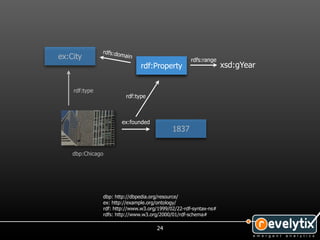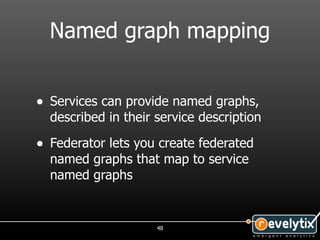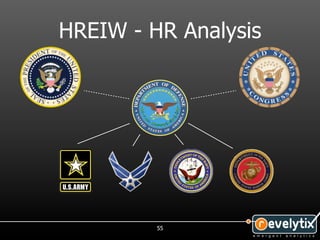Ad
Releasing Relational Data to the Semantic Web
- 1. Releasing Relational Data to the Semantic Web Alex Miller [email protected] 1
- 2. Semantic web Relational data Federation HREIW Analytics 2
- 3. There are things we wish to describe. 3
- 4. We need some way to identify each thing. 4
- 5. A URI is abo ut "identifying" things, not "locating" things (a URL). On the web, we identify things with a URI. 5
- 6. dbp:Chicago_(band) dbp:Wrigley_Field dbp:The_Blues_Brothers_(film) dbp:Chicago dbp:Chicago_Cubs dbp:Barack_Obama dbp:Pizza dbp: http://dbpedia.org/resource/ 6
- 7. Things are more interesting if we relate them. Relationships are also described by a URI. 7
- 8. dbp:Chicago_(band) dbp:The_Blues_Brothers_(film) dbp:Wrigley_Field n db tio po oca :lo c _l m at ion :fil ie ov m dbpo:owner dbp:Chicago dbp o:r e si den c e dbp:Chicago_Cubs dbp:Barack_Obama dbp:Pizza dbp: http://dbpedia.org/resource/ dbpo: http://dbpedia.org/ontology/ 8
- 10. Subject dbp:Chicago_(band) dbp:The_Blues_Brothers_(film) dbp:Wrigley_Field Predicate n db tio po ca :lo o ca _l m tio fil Object : n ie ov m dbpo:owner dbp:Chicago dbp o:r e si den c e dbp:Chicago_Cubs dbp:Barack_Obama dbp:Pizza dbp: http://dbpedia.org/resource/ dbpo: http://dbpedia.org/ontology/ 10
- 11. <subject> <predicate> <object> dbp:Wrigley_Field dbpo:location dbp:Chicago resource resource resource or value 11
- 12. dbp:Chicago_(band) dbp:The_Blues_Brothers_(film) dbp:Wrigley_Field n db tio po oca :lo c _l m at ion :fil ie ov m dbpo:owner dbp:Chicago dbp o:r e si den c e dbp:Chicago_Cubs dbp:Barack_Obama dbp:Pizza dbp: http://dbpedia.org/resource/ dbpo: http://dbpedia.org/ontology/ 12
- 13. Congratulations! You now know RDF. 13
- 14. If things and relationships can be defined by any URI, how do we know what we're talking about? 14
- 15. We need metadata. 15
- 16. Specifically, we need a vocabulary of common terms that describe our data. 16
- 17. A class describes a group of things that share common properties. 17
- 18. ex:City is a is a is a dbp:San_Francisco dbp:Chicago dbp:Saint_Louis dbp: http://dbpedia.org/resource/ ex: http://example.org/ontology/ rdf: http://www.w3.org/1999/02/22-rdf-syntax-ns# rdfs: http://www.w3.org/2000/01/rdf-schema# 18
- 19. ex:City rdf:type rdf:type rdf:type dbp:San_Francisco dbp:Chicago dbp:Saint_Louis dbp: http://dbpedia.org/resource/ ex: http://example.org/ontology/ rdf: http://www.w3.org/1999/02/22-rdf-syntax-ns# rdfs: http://www.w3.org/2000/01/rdf-schema# 19
- 20. rdfs:Class rdf:type ex:City rdf:type rdf:type rdf:type dbp:San_Francisco dbp:Chicago dbp:Saint_Louis dbp: http://dbpedia.org/resource/ ex: http://example.org/ontology/ rdf: http://www.w3.org/1999/02/22-rdf-syntax-ns# rdfs: http://www.w3.org/2000/01/rdf-schema# 20
- 21. rdf:type ex:Location rdfs:Class rdfs:subClassOf rdf:type ex:City rdfs:Class dbp: http://dbpedia.org/resource/ ex: http://example.org/ontology/ rdf: http://www.w3.org/1999/02/22-rdf-syntax-ns# rdfs: http://www.w3.org/2000/01/rdf-schema# 21
- 22. Classes let us talk about kinds of things. Now we need some way to describe attributes. 22
- 23. ex:City rdf:type ex:country ex:founded dbp:United_States 1837 dbp:Chicago dbp: http://dbpedia.org/resource/ ex: http://example.org/ontology/ rdf: http://www.w3.org/1999/02/22-rdf-syntax-ns# rdfs: http://www.w3.org/2000/01/rdf-schema# 23
- 24. rdfs:do ex:City main rdfs:range rdf:Property xsd:gYear rdf:type rdf:type ex:founded 1837 dbp:Chicago dbp: http://dbpedia.org/resource/ ex: http://example.org/ontology/ rdf: http://www.w3.org/1999/02/22-rdf-syntax-ns# rdfs: http://www.w3.org/2000/01/rdf-schema# 24
- 25. Congratulations! You now know RDF Schema. 25
- 26. How do we find stuff in this data? SPARQL 26
- 27. ex:Baseball_Team ex:Stadium ex:City rdf:type rdf:type rdf:type dbpo:owner dbpo:location dbp:Chicago dbp:Chicago_Cubs dbp:Wrigley_Field dbp: http://dbpedia.org/resource/ dbpo: http://dbpedia.org/ontology/ 27
- 28. ex:Stadium ex:City rdf:type rdf:type dbpo:owner dbpo:location ?owner ?stadium ?city 28
- 29. ex:Stadium ex:City ?stadium rdf:type ex:Stadium . ?city rdf:type ex:City . rdf:type rdf:type dbpo:owner dbpo:location ?owner ?stadium ?city ?owner dbpo:owner ?stadium . ?stadium dbpo:location ?city . 29
- 30. ex:Stadium ex:City ?stadium rdf:type ex:Stadium . ?city rdf:type ex:City . rdf:type rdf:type dbpo:owner dbpo:location ?owner ?stadium ?city ?owner dbpo:owner ?stadium . ?stadium dbpo:location ?city . SELECT ?owner ?stadium ?city WHERE { ?owner dbpo:owner ?stadium . ?stadium dbpo:location ?city . ?stadium rdf:type ex:Stadium . ?city rdf:type ex:City . } 30
- 31. Unions Joins SPARQL Outer joins Filter with criteria Project expressions Sort Duplicate removal Slice (limit / offset) Aggregates (grouping, etc) Subqueries 22 31
- 32. Semantic web Relational data Federation HREIW Analytics 32
- 33. Sounds interesting. But my data is in a relational database! 33
- 34. Music Database Musicians: MID First Last Inst_ID 1 Eddie Van Halen 10 2 Yo Yo Ma 20 3 Kenny G 30 Instruments: IID Instrument Type 10 Guitar String 20 Cello String 30 Saxophone Woodwind 34
- 35. Musician Schema rdfs:Class rdf:Property rdf:type rdf:type rdfs:domain music:firstName music:Musician rdfs:doma in rdfs music:lastName :dom ain rdfs:range music:plays music:Instrument rdfs:dom ain rdfs :do music:instName mai n music:instType 35
- 36. Triples From Tables Musicians: Instruments: MID First Last Inst_ID IID Instrument Type 1 Eddie Van Halen 10 10 Guitar String 2 Yo Yo Ma 20 20 Cello String 3 Kenny G 30 30 Saxophone Woodwind Turn each key into a resource and specify the proper type of each resource: artist:1 rdf:type music:Musician instrument:10 rdf:type music:Instrument artist:2 rdf:type music:Musician instrument:20 rdf:type music:Instrument artist:3 rdf:type music:Musician instrument:30 rdf:type music:Instrument 36
- 37. Triples From Tables Musicians: Instruments: MID First Last Inst_ID IID Instrument Type 1 Eddie Van Halen 10 10 Guitar String 2 Yo Yo Ma 20 20 Cello String 3 Kenny G 30 30 Saxophone Woodwind Turn each cell into a triple based on the key, property (mapped per column), and value: artist:1 music:firstName "Eddie" instrument:10 music:instName "Guitar" artist:1 music:lastName "Van Halen" instrument:10 music:instType "String" artist:2 music:firstName "Yo Yo" instrument:20 music:instName "Cello" artist:2 music:lastName "Ma" instrument:20 music:instType "String" artist:3 music:firstName "Kenny" instrument:30 music:instName "Saxophone" artist:3 music:lastName "G" instrument:30 music:instType "Woodwind" 37
- 38. Triples From Tables Musicians: Instruments: MID First Last Inst_ID IID Instrument Type 1 Eddie Van Halen 10 10 Guitar String 2 Yo Yo Ma 20 20 Cello String 3 Kenny G 30 30 Saxophone Woodwind Turn each foreign key reference into a relationship between the foreign and primary resources. artist:1 music:plays instrument:10 artist:1 music:plays instrument:20 artist:2 music:plays instrument:30 38
- 39. R2RML • "Relational to RDF Mapping Language" • RDB2RDF Working Group at W3C • ETL "data transformation" use case • Dynamic "query translation" use case • SPARQL to SQL 39
- 40. R2RML Triple Mapping ain music:instName rdfs:dom music:Instrument rdfs:d omain music:instType Instruments: IID Instrument Type 10 Guitar String 40
- 41. R2RML Triple Mapping ain music:instName rdfs:dom music:Instrument rdfs:d omain music:instType Triples Map rr:tableName Instruments: IID Instrument Type 10 Guitar String 40
- 42. R2RML Triple Mapping ain music:instName rdfs:dom music:Instrument rdfs:d omain rr:class music:instType Subject Map "http://example.com/music/ Inst-{iid}" Triples Map rr:tableName Instruments: IID Instrument Type 10 Guitar String 40
- 43. R2RML Triple Mapping ain music:instName rdfs:dom music:Instrument rdfs:d omain rr:class music:instType rr:predicate Subject Map "http://example.com/music/ Inst-{iid}" Predicate Map Predicate Object Map Object Map Triples Map rr:tableName Instruments: rr:column IID Instrument Type 10 Guitar String 40
- 44. @prefix rr: <http://www.w3.org/ns/r2rml#> . @prefix music: <http://example.com/music/> . @prefix mapping: <http://example.com/ont/> . mapping:InstrumentMapping a rr:TriplesMapClass; rr:tableName "Instruments"; rr:subjectMap [ rr:template "http://example.com/music/Inst-{iid}"; rr:class music:Instrument ]; rr:predicateObjectMap [ rr:predicateMap [ rr:predicate music:instName ]; rr:objectMap [ rr:column "instrument" ]; ]; rr:predicateObjectMap [ rr:predicateMap [ rr:predicate music:instType ]; rr:objectMap [ rr:column "type" ]; ]; . 41
- 45. SPARQL translation SPARQL Solutions R2RML SQL Results Database 42
- 46. Semantic web Relational data Federation HREIW Analytics 43
- 47. SPARQL Protocol • Standard HTTP API for calling a SPARQL processor • Supported by all major triple stores and query processors 44
- 48. SPARQL Federation SELECT ?artist ?song ?buyLink Return Federated data WHERE { SERVICE <http://listening> { ?listened rdf:type listen:event . Call SPARQL endpoint that tracks ?listened listen:artist ?artist . your listening (like last.fm) ?listened listen:song ?song } OPTIONAL { SERVICE <http://amazon> { Call Amazon endpoint to get info ?isbn rdf:type amaz:mp3 . on where to download the song. ?isbn amaz:artist ?artist . ?isbn amaz:song ?song . ?isbn amaz:link ?buyLink } } } 45
- 49. Service Descriptions 46
- 50. Federator SPARQL Endpoint Ontology and Federator service registry R2RML Web SPARQL Endpoint Endpoint Endpoint Data Db Triple base pedia Store 47
- 51. Named graph mapping • Services can provide named graphs, described in their service description • Federator lets you create federated named graphs that map to service named graphs 48
- 52. Data integration • Performance - data volume from sources is key • Source capabilities • Source statistics 49
- 53. Performance concerns: data volume SELECT ... FILTER (?age >= 24) ... Reduction factors: •criteria Domain •minimal projection Results Query •aggregation •joins (sometimes) •dup removal WHERE Person.age >= 24 50
- 54. Performance concerns: federated joins 51
- 55. Data source capabilities • SQL support • Function support • Function translation • Inverse functions • Data type mappings and translations 52
- 56. Data source statistics • Table cardinality • Column selectivity • Column null density • Join selectivity 53
- 57. Semantic web Relational data Federation HREIW Analytics 54
- 58. HREIW - HR Analysis 55
- 59. “Which Marines that speak French and/ or French Creole have had at least six months since their last deployment?” 56
- 60. “How many discharges were the result of the Don’t Ask Don’t Tell policy per year?” 57
- 61. “What is the average length of service for soldiers deployed in Afghanistan vs Iraq?” 58
- 62. Where’s the data? 59
- 63. Ontologies HR Standards HR Domain Mapping Sources 60
- 64. Technologies cs Analyti y HR Standards Ontolog ment develo p HR Domain SPARQL Federation Mapping Rule s Sources SPARQL to database 61
- 65. Collaborative Ontologies model Domain ontology wiki discuss Ontologist Subject Matter Experts diagram discuss 62
- 66. Ontology Visualization 63
- 67. Semantic web Relational data Federation HREIW Analytics 64
- 68. RIF • Rule Interchange Format, W3C recommendation • Rule = IF - THEN statement • Used to derive new triples from existing triples • Dialects • Core • Framework for Logic Dialects (FLD) • Basic Logic Dialect (BLD) • Production Rules Dialect (PRD) • Rex - Revelytix RIF Core implementation 65
- 69. Dashboards 66
- 70. Dashboards 67
- 71. Dashboards 68
- 72. Enterprise Semantic Web • Knoodl - collaborative ontology creation • OntVis - ontology visualization (OWL) • Spyder - SPARQL to SQL (RDF, R2RML) • Federator - SPARQL federation (SPARQL 1.1, SPARQL Federation extensions) • Rex - entailment with rules (RIF) • Dashboards - analytics, visualization 69
- 73. More information • Revelytix - http://revelytix.com • Knoodl - http://knoodl.com • OntVis - http://bit.ly/hLm3sd • Spyder - http://revelytix.com/content/spyder • Federator - beta coming soon... • Rex - beta coming soon... 70












































![@prefix rr: <http://www.w3.org/ns/r2rml#> .
@prefix music: <http://example.com/music/> .
@prefix mapping: <http://example.com/ont/> .
mapping:InstrumentMapping
a rr:TriplesMapClass;
rr:tableName "Instruments";
rr:subjectMap [
rr:template "http://example.com/music/Inst-{iid}";
rr:class music:Instrument
];
rr:predicateObjectMap [
rr:predicateMap [ rr:predicate music:instName ];
rr:objectMap [ rr:column "instrument" ];
];
rr:predicateObjectMap [
rr:predicateMap [ rr:predicate music:instType ];
rr:objectMap [ rr:column "type" ];
];
.
41](https://image.slidesharecdn.com/relationalsemanticweb-110414220025-phpapp01/85/Releasing-Relational-Data-to-the-Semantic-Web-44-320.jpg)


















































































